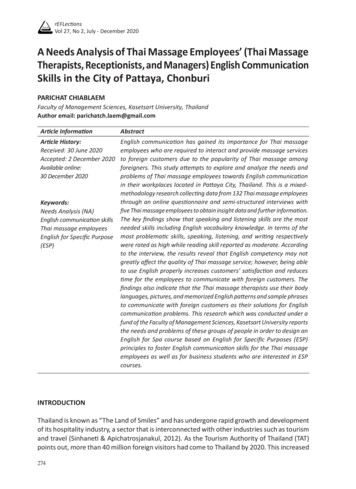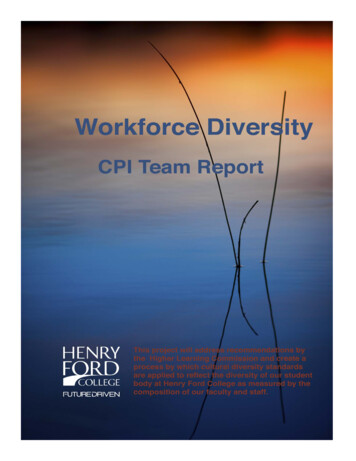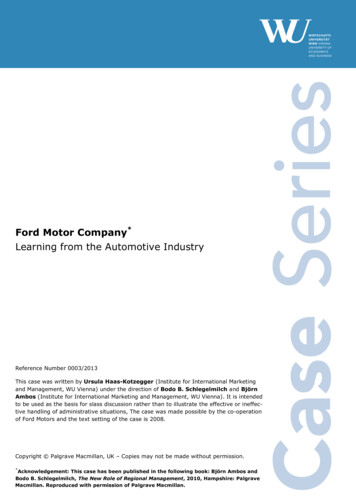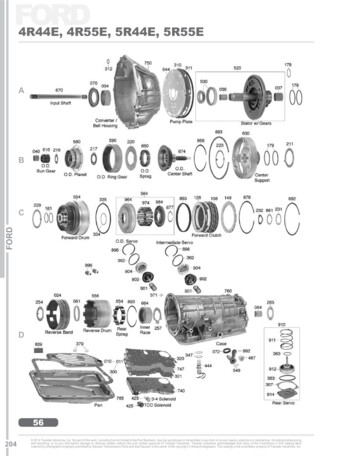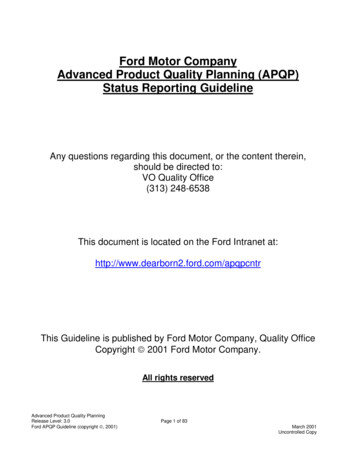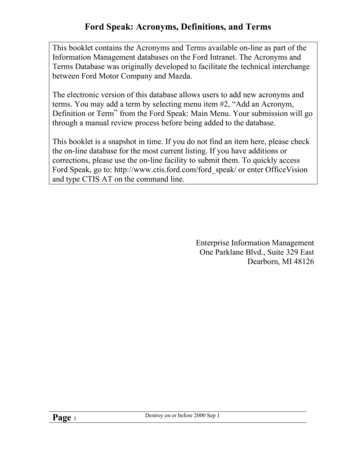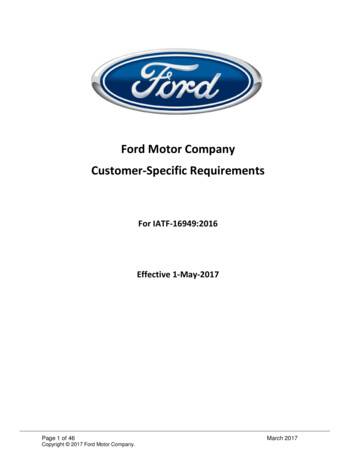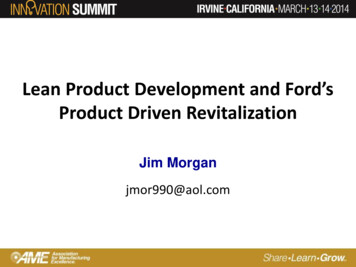
Transcription
International Journal of Business and Social ScienceVol. 5, No. 10(1); September 2014Employees Management Analysis at Ford Motor CompanyYang YangShanghai University of Engineering ScienceLong Teng Street, NO.333, Shanghai 201620ChinaAbstractEmployee management as an important part of the human resource management of a company's development hasplayed a crucial role. In this paper, Ford Motor Company, for example, a detailed exposition of the Ford MotorCompany on good management of Employee .From a Ford plan, employee satisfaction, employee engagement,leadership development, develop future talent five points of view of employee management and development. Thispaper studies the Ford Motor Company from 2007 to 2012 the average annual employment of employees,employee satisfaction of Ford's staff management. Professionals available for reference.Keywords: Employee management; Supporting ONE Ford; Employee Satisfaction; Employee EngagementAnalysis; Leadership Development; Developing Future TalentIn a company, analysis on staff management is an important work of human resource management. In order tomake the reader a better understanding of how the company is managed staff paper from Ford Motor Company'semployee management for a detailed description and explanation.1. Ford Motor Company Profile1.1 Basic IntroductionFord Motor Company is one of the world's largest automotive companies. 1903 founded by Mr. Henry Ford in theU.S. city of Detroit. Now Ford Motor Company is the world's super-multinationals headquartered in Dearborn,Michigan.1.2 EmployeesHere at Ford, employees are the driving force behind Ford’s success. Ford’s recent financial recovery can beattributed in large part to the dedication and strong performance of Ford’s workforce, which pulled together underFord’s ONE Ford plan to restructure and return Ford’s North American operations to profitability. The same planis currently guiding Ford’s restructuring efforts in Europe, where Ford made the difficult decision to close twoU.K. facilities in 2013 and end production at a major assembly plant in Genk, Belgium, at the end of 2014.Today, Fordis hiring again in North America and in other parts of the world. In the U.S., Ford has filled more than9,000 of the 12,000 new hourly jobs Ford forecasted to deliver by 2015 during 2011 contract discussions with theUAW1. In 2012 Ford added more than 8,100 combined hourly and salaried jobs in the U.S., and in early 2013Ford announced plans to hire 2,200 more salaried workers. In Asia Pacific and Africa, Ford added 2,470 hourlyand salaried jobs in 2012 to help keep pace with product demand in that region[2].As the Company continues to strengthen and grow in many regions, Ford’s employees are able to share in oursuccess. In early 2013, for example, eligible U.S. hourly employees received average profit-sharing payments of 8,300 for the 2012 performance year. Salaried employees also received bonuses under the Annual IncentiveCompensation Plan.Ford Company has a compelling vision of building cars and trucks that deliver the very best in quality, safety, fuelefficiency and design. And their employees are helping them do just that. A skilled and motivated workforce isthe essence of Ford – today and in the future[3]. They’re focused on developing a diverse, skilled and motivatedteam, while providing a safe, respectful and inclusive environment.80
Center for Promoting Ideas, USAwww.ijbssnet.comTheir goal is to attract, develop, engage and retain the talent they need to Go Further. To grow their pipeline oftalent, particularly in the areas of science, technology, engineering and math (STEM), they’re reaching out todiverse communities through our Partnership for Advanced Studies, professional organizations such as theSociety for Women Engineers, and various scholarship programs.Ensuring a great place to work requires an understanding of employee satisfaction and what employees valueabout being part of Ford Motor Company. They engage employees as individuals and foster leadershipdevelopment in a diverse environment where people feel valued and included. A safe workplace and a healthyworkforce are also critical elements of their strategy[4].In the U.S., automakers are competing for talent, and they have stepped up our efforts to find the best people.They are using social media more than ever in our recruiting efforts and hosting webinars and virtual career fairsto expand their reach.As of December 2012, they employed approximately 171,000 individuals globally. Ninety-five percent of thehourly employees in theirautomotive operations are covered by collective bargaining agreements and arerepresented by 39 different unions globally. In the United States, approximately 99 percent of these unionizedhourly employees in theirautomotive sector are represented by the UAW. Approximately 2 percent of their U.S.salaried employees are represented by unions. Most hourly employees and many non-management salariedemployees of their subsidiaries outside the U.S. are also represented by unions [5]. These unions are key partnerswith Ford in providing a safe, productive and respectful workplace. Company employees in 2007 to 2012 in Table1 below1:Average number of people employedTable 1: Employment by Business UnitTotalAutomotiveFinancial ble 1 shows: these employee numbers do not include dealer personnel; 2009 employee numbers have beenadjusted to reflect the new accounting standard on the deconsolidation of many of their variable interest entities.1.3 Supporting ONE FordWhile they have many types of employees and work arrangements, all of their employees together create a skilledand motivated team aligned around their overall ONE Ford objectives. Their ONE Ford plan aligns their effortstoward a common definition of success: having ONE Team, ONE Plan and ONE Goal for an exciting, viable Fordthat delivers profitable growth for all. ONE Ford also provides consistent goals and expectations for employees –whether they work in the U.S., China or one of their other global locations – with a clear focus on the skills andbehaviors they must demonstrate to accomplish their goals[6]. All members of their global team are heldaccountable for incorporating ONE Ford into their daily work.They have integrated ONE Ford into their people processes to support employee development and driveaccountability for moving the Company forward while demonstrating expected behaviors that are fundamental tothe success of ONE Ford:F: Foster Functional and Technical ExcellenceO: Own Working TogetherR: Role Model Ford ValuesD: Deliver ResultsOver the last few years, implementing the ONE Ford plan has meant that they have focused their strategies onfour key goals: creating a great place to work; developing a capable and effective workforce; aligning theirorganizational structure with their global business footprint; and providing the “people”- related processes tosupport their workforce.81
International Journal of Business and Social ScienceVol. 5, No. 10(1); September 2014In early 2012, they extended the ONE Ford approach with their new Go Further campaign, which embodies theircommitment to their customers. ONE Ford is their roadmap and plan, while Go Further is the promise behindtheir efforts.Figure 1: Supporting ONE Ford FosterFunctionaland TechnicalExcellence OwnWorkingTogetherFODR DeliverResults Role ModelFord Values2. Employees Management Analysis2.1 Employee SatisfactionEach year, they ask their salaried workforce to participate in the Pulse survey to gain insight into employees’overall satisfaction with the Company, their jobs, diversity and other aspects of their workplace experience. Theyencourage their employees to provide candid feedback, and they benchmark results and participation externally.Results of the survey are incorporated into their business planning review processes. Improving Pulse scores is anannual performance objective for many of their senior managers.In 2012, 75 percent of their salaried employees across the globe participated in the survey, which included a totalof 55 multiple-choice questions across 12 dimensions of workplace life, including training and development,management’s commitment to diversity, and workplace safety practices. The results of the 2012 survey werehighly favorable, with nine of the dimensions improved over 2011 and two unchanged. One dimension, whichmeasured employee awareness and understanding of the Company’s Go Further brand promise, was new for the2012 survey.The Employee Satisfaction Index (ESI) section of the survey, which asks employees’ questions such as whetherthey feel valued at work or whether they believe they are rewarded for their job performance, increased 2percentage points from 2011. Considered the bellwether of employee satisfaction, Ford’s ESI score is 5percentage points above the Company’s benchmark, which is comprised of a group of Fortune 500 companies.Within the ESI, the highest score – 13 percent above the external benchmark – was for the question that askedemployees whether they feel satisfied with the information they receive from management on what’s going onwith the Company.This year’s survey also showed improvement – an increase of 4 percentage points – over last year in the area thatmeasures management’s commitment to diversity. Two of the five questions that improved most were from thediversity category[7].Not all questions saw improved results, however. Questions that resulted in lower scores this year included:(1) “My workload does not interfere with my ability to do a quality job” – down 2 percentage points from theprior year to 64 percent.(2) “My work group planned actions based on the results of the last Pulse survey” – down 1 percentage point to66 percent.82
Center for Promoting Ideas, USAwww.ijbssnet.comIn 2012, they surveyed hourly employees on health and safety, along with other topics, for the first time. Theobjective was to collect feedback from their hourly workforce to establish baseline metrics, measure theeffectiveness of the ONE Ford strategy and its impact on employee satisfaction, and guide continuousimprovement efforts in their manufacturing operations. Plant locations in nine countries participated, generatingfeedback from more than 22,000 employees. The survey included a minimum of 20 questions that were consistentwith questions asked in the salaried Pulse survey. Regions could add more questions as needed. The mostfavorable responses were around Company mindset and quality work practices. Results were slightly below thesalaried workforce scores, but within 10 percentage points. Improvement efforts will focus on the effectiveimplementation of their overall Ford Production System, which encompasses safety, quality, delivery, cost,people, maintenance and environment. As part of their efforts to increase satisfaction, they are constantlyimproving their strategies for fostering open dialogue with employees[8].In addition, each year following the survey, they send managers and supervisors throughout Ford a report thatshows how their specific teams responded to the questions on the survey. The goal is for the managers andsupervisors to then meet with their work group, discuss the results, and plan changes to improve the way theirteams function. Employee Satisfaction, Pulse Survey as shown in table 2.Percent satisfiedTable 2: Employee Satisfaction, Pulse SurveyEmployee Satisfaction IndexCompany Success MindsetManagement Commitment toDiversityOvercoming 1068848220116984822012718686606264626366As can be seen from Table 2: each year, they ask their salaried workforce to participate in the Pulse survey to gaininsight into employees’ overall satisfaction with the Company, their jobs, diversity and other aspects of workplacesatisfaction.In 2012, the Employee Satisfaction Index continued a nine-year trend of scores equal to or better than the prioryear. The topic of Management Commitment to Diversity continued a six-year trend of scores equal to or betterthan the prior year.2.2 Employee Engagement Analysis(1)Keeping their employees engaged with their Company overall, and encouraging them to stay connected withtheir peers and their communities, is an essential component of their people strategy here at Ford. They believeit’s important to communicate with their workforce in ways that are open and transparent. They do so through avariety of interactive forums, from “town hall” meetings to intranet surveys and chats, from joint labormanagement committees to diversity councils. They also use several publications, such as plant newsletters andtheir @Ford magazine, to communicate the latest information on the state of the Company and their products. Inrecent years, they have also increased their use of social media applications, such as Facebook, to inform andconnect with their employees.(2)For their hourly employees, they work closely with their unions to develop agreements and governance plansover changes in their operations (e.g., reorganizations, plant shutdowns, employee transfers and reductions). Inaddition, joint labor/management committees are set up at each plant to give employees an opportunity toinfluence working conditions and practices.(3)For their salaried employees, most of whom are not covered by union agreements,they have a strong Code ofConduct and comprehensive Policy Letters and Directives covering topics, including diversity, relevant to theiremployees. They also practice regular two-way communication with all employees through webcasts, executiveQ&A sessions between senior leadership and staff who wouldn’t typically have face-to-face meetings with toplevel management, quarterly “town hall” meetings, manager-to-employee business cascades, surveys and informalcommunications. They survey thei
Employee management as an important part of the human resource management of a company's development has played a crucial role. In this paper, Ford Motor Company, for example, a detailed exposition of the Ford Motor Company on good management of Employee .From a Ford plan, employee satisfaction, employee engagement, leadership development, develop future talent five points of view

